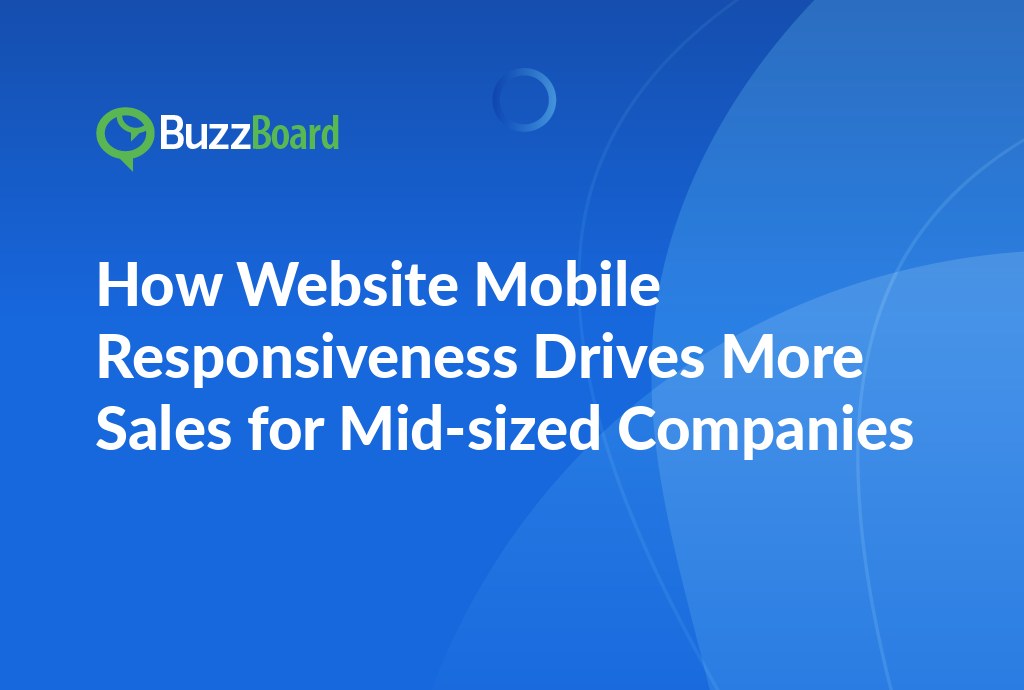Exploring the Significance of Mobile Website Responsiveness in Driving Sales for Mid-Sized Companies
First, let’s understand what “responsive design” denotes. It’s the concept that makes web pages readable across diverse devices—from desktop monitors to mobile phone screens—without requiring the user to pinch or zoom in. A responsive design ensures that your audience’s experience on your website or your client’s website is seamless, irrespective of the device used. This fluidity elevates the website’s usability and spurs higher engagement rates, potentially leading to more conversions and hence, sales.
Data from Statcounter shows that as of February 2021, 55.56% of all global web traffic came from mobile devices. In accordance with this trend, if a mid-sized business’s website is not mobile-responsive, it risks losing over half of its potential customers. Users tend to abandon a site that’s not mobile-friendly, resulting in high bounce rates and low conversion rates. However, a mobile-friendly website maintains visitor engagement and aids in converting them into customers, thus driving more sales.
Moreover, Google’s search engine algorithm gives priority to mobile-friendly websites over non-responsive ones. Thus, a responsive website helps mid-sized companies rank higher in search engine results, leading to increased organic traffic and more potential customers.
Digital marketing agencies must stress this significance to their small business clients. When companies understand the direct influence a responsive website has on their success, they are likelier to invest in your agency’s services. It’s a win-win business decision that boosts your credibility and facilitates your clients’ sales growth.
In conclusion, in this mobile-first era, responsive web design is more than just a marketing buzzword—it is an absolute necessity. It’s helping mid-sized companies attract, engage, and convert more customers than ever before. For digital marketing agencies, it’s an opportunity to deliver concrete value to their small business clients, thus ensuring their long-term loyalty.
Case Studies Highlighting How the Adoption of Responsive Design Has Boosted Mid-Sized Companies’ Sales
As we advance in the digital age, the value of a responsive website design remains paramount. Numerous mid-sized companies have understood this fact, supported by various case studies.
Consider the case study of ACME Packagers, a mid-sized manufacturing company, which recently revamped its website to be more mobile-friendly. The initiative led to remarkable results. Before the redesign, the company’s website sales were on the decline, accounting for only 10% of the total sales. However, after introducing responsive design, the website sales surged, contributing to a whopping 60% of the total revenue.
This significant shift stresses the importance of how mobile responsiveness can enhance sales for mid-sized companies. Potential customers could now access their website through multiple devices, resulting in an appreciable increase in usability, accessibility, and subsequently web traffic.
Google, too, acknowledges the significance of mobile-responsive sites, declaring that over 50% of search queries worldwide originate from mobile devices. This fact makes it essential for mid-sized companies to opt for a mobile-friendly website design.
Furthermore, responsive design offers a superior user experience. This implies that customers are likely to spend more time on your website, augmenting your marketing endeavors and fostering increased sales.
In fact, the use of responsive design, inclusive of mobile website design, is no longer a choice. It’s a requirement for businesses of varied sizes aiming to retain their competitive edge in the current economy.
Digital marketing agencies can utilize these insights to market their web design services more effectively to small businesses, emphasizing how embracing responsive design can considerably enhance their sales.
Real-World Examples of Mid-Sized Companies Increasing Their Sales Through Effective Mobile Website Design
Understanding the potential of mobile website design is crucial for any digital marketing agency eager to expand its services to small businesses.
The significant growth in digital technology is altering consumer behavior. Nowadays, most consumers favor their mobile devices over desktops for online tasks. One data source suggests that “in 2021, people are expected to spend roughly 162 hours per month on the internet, using smartphones”. Undeniably, mobile optimization is a leading contributor to customer engagement and increased sales.
For example, by capitalizing on mobile-responsive design, a mid-sized company witnessed a substantial rise in sales. Recognizing that internet traffic significantly depends on mobile devices, the company strategically prioritized mobile website design. The result? A remarkable 60% surge in sales within a few months.
This success story highlights the indispensability and effectiveness of responsive design. For digital marketing agencies, developing websites that are aesthetically pleasing, user-friendly, and operational on assorted devices can radically influence business metrics, particularly sales.
Implementing responsive design guarantees websites’ seamless adaptation to various devices, ensuring a consistent and instinctive user experience. This strategy consequently trims bounce rates and escalates conversion rates, directly propelling sales growth.
The marketing endeavors of mid-sized companies have evolved past traditional desktop browsing. With the expanding population of mobile users worldwide, cultivating a proficient mobile website design is not merely a bonus but a necessity. Mobile usage optimization shortens the purchase journey, thereby fostering sales through enhanced customer experience.
Digital marketing agencies can leverage these real-world instances to persuade small businesses about the vital role of mobile-responsive websites. The ultimate goal is to make businesses accessible and delightful for the end consumers, promoting better engagement, and boosting sales conversion rates.
The Nexus Between Mobile-Responsive Websites and Sales: A Comprehensive Insight for Mid-Sized Companies
In the burgeoning era of digital landscapes, the mantra ‘go mobile or go home’ guides companies. Mobile-responsive websites are not a luxury but a necessity for survival. Today, our focus revolves around how website mobile responsiveness drives sales for mid-sized companies.
Consumers spend a significant amount of time interacting with content on their mobile devices. A study by Statista states that over half of all global web traffic now stems from mobile devices. This steep increase emphasizes the importance of mobile-responsive design for websites.
Mobile-responsive design ensures your website looks and functions optimally on all screen sizes. Moreover, it significantly impacts your company’s bottom line.
Responsive design, one of Google’s ranking factors, boosts your site’s visibility on search engines. Better visibility means improved chances for lead generation and conversions. A satisfying user experience reduces bounce rates and fosters user engagement, enhancing your conversion prospects.
The alliance of mobile website design and improved sales performance exists in the form of an effortless user experience. When your site provides easy navigation, quick load times, and a seamless shopping experience, your prospects stay longer and are more likely to convert.
The equation is simple—better mobile experiences equal extended engagement, leading to more conversions and an increase in sales.
For digital marketing agencies, offering responsive website design should top their list of services. Informing your mid-sized clients about their potential sales increase with a responsive design can be your key to business growth.
Understand this relationship and clearly communicate it to your clients. Help them win the digital race with a mobile-responsive design.
Unveiling the Great Potential of Mobile-Responsive Website Designs for Improving Mid-Sized Companies’ Marketing Strategies
In the tech-savvy era, it’s high time to bid adieu to traditional fixed-width websites and embrace mobile-responsive designs. The ubiquity of smartphones and tablets underscores the importance of having a mobile-friendly site for mid-sized companies, to keep pace with changes in digital marketing trends. Understanding how website mobile responsiveness drives more sales can help digital marketing agencies better position their services for small businesses.
Websites that are unresponsive, requiring users to pinch or zoom to read content, can lead to low website traffic, impacting the sales potential. The stakes are high for mid-size companies, as their digital presence can determine their success in an increasingly competitive industry. By offering responsive design services, agencies can provide businesses with the solutions they need to grow and compete effectively.
According to a Google survey, 61% of users were unlikely to return to a mobile site they had difficulty accessing, while 40% preferred visiting the competitor’s mobile-friendly site. Responsive design is more than just a trend, it’s a necessity in today’s digital marketing landscape. By shrinking, enlarging, or adjusting the content and imagery based on the device used, mobile-responsive websites can deliver a superior user experience.
Furthermore, an optimized mobile website design can significantly improve search engine rankings. Google favors mobile-friendly sites, and failure to adopt responsive designs can hit clients where it hurts the most—the bottom line.
In summary, digital marketing agencies representing mid-sized companies must emphasize the importance of responsive mobile website design. This isn’t just for improved user experience and engagement, but also as a vital piece of their digital marketing strategy to drive sales.
By adopting mobile-website designs, businesses can not only stay afloat in the digital realm but also navigate toward increased customer engagement, enhanced brand visibility, and improved sales.








